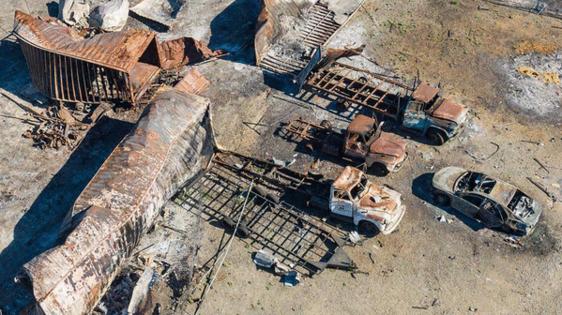Cal Fire knew Esparto site had fireworks. Should it have checked local permits?
Published in News & Features
SACRAMENTO, Calif. — After an explosion in Esparto last month killed seven people and burned more than 70 acres, the Office of the State Fire Marshal quickly pointed out that safety inspections and local permits are not under their purview.
As the investigation into the tragedy enters its seventh week, records have unearthed a troubling gulf in California’s otherwise strict explosives oversight: the system depends on small, often underfunded, local agencies to enforce permits and inspections without providing much support to those agencies or double-checking their work.
In this case, both the Yolo County Sheriff’s Office and the Esparto Fire Protection District — two of a handful of entities that could have inspected or approved the fireworks facility — had personal and financial links to it.
The blast has left state regulators and lawmakers questioning how a facility openly listed on state fireworks licenses for years could operate without the critical inspections.
Could the state have intervened?
“Inspections of storage facilities are the responsibility of the authority having jurisdiction (the local fire department),” Cal Fire said two days after the explosion.
The Office of the State Fire Marshal makes regulations related to the safe use, transport and storage of explosives, Cal Fire said. “Under those regulations local law enforcement and fire agencies track the location of storage magazines within their jurisdictions through a permit process.”
But in Esparto, no permits were issued and the local fire agency didn’t inspect the fireworks facility. Fire Chief Curtis Lawrence said he only conducted “site visits” for “pre-planning” in the event of an emergency. Lawrence declined to be interviewed by The Sacramento Bee.
Cal Fire never visited the facility before the explosion, State Fire Marshal Dan Berlant has said. But the fire agency — more the Office of the State Fire Marshal — did approve applications from two fireworks companies that said they would store dangerous explosives there.
Records obtained by The Sacramento Bee show that from 2020 to 2025, Cal Fire approved fireworks license renewals for Devastating Pyrotechnics’ CEO Kenneth Chee six times. Each time, Chee told the agency that his company’s sole storage facility was the property in Esparto. Cal Fire approved BlackStar Fireworks’ owner Craig Cutright’s fireworks licenses twice, which also reported that the Esparto property was the company’s only storage site. Those permits have since been suspended.
Fireworks license applications always include the storage location where fireworks will be kept, but Cal Fire does not verify those locations meet California Fire Code requirements, the agency said. “The (Office of the State Fire Marshal) issues the license, the authority having jurisdiction then issues a local permit,” Cal Fire said.
Under state law, local permitting cannot happen until a state fireworks license is obtained, so Cal Fire is not able to verify an applicant’s storage location is up to code before giving them a license.
When that facility is already on Cal Fire’s radar, like when an annual license renewal lists the same facility, it would be possible to verify that local permits have been issued before renewing the license- but Cal Fire does not do so.
“The law does not require a reach out to local authorities,” a representative for the Office of the State Fire Marshal said. “While making that notification would not be a big burden, it would not solve the problem as it exists today.”
When the agency reviews an application, there are a few steps taken to vet applicant information. Applicants must sign a perjury statement and submit to a LiveScan background check before Cal Fire will issue them a license to work with fireworks, the agency said.
State regulators and industry experts describe California as a state with tight regulations on explosives, but the Esparto explosion raises questions about how quietly this facility slipped through the cracks. Employees of both the county sheriff and the local fire department, the two agencies tasked with ensuring fireworks storage facilities have the proper permits, have been linked to the fireworks facility, leading to recusals and concerns about conflicts of interest.
Cal Fire has been working with legislators interested in fireworks regulation since the explosion, the Office of the State Fire Marshal said. That effort comes on the heels of a “major overhaul” that was already in the works. That overhaul will be influenced by the findings of the Esparto investigation.
Cal Fire plans to bring together public safety and fire officials to review regulations and recommend any necessary updates.
Rural fire districts are overburdened, underfunded
State regulations appear to place the highest burden on the agencies with the lowest budgets. In Yolo County, 15 small fire protection districts like Esparto are struggling with staffing and budgetary shortages despite the fact that their emergency preparedness can be a matter of life and death.
“It is a real challenge with the amount of staff we have to provide adequate level of service for approximately 25 square miles,” Mark D’Ambrogi, fire marshal for the Placer Hills, Penryn and Newcastle fire districts in Placer County, said. Penryn and Placer Hills usually have two firefighters on duty at a time, Newcastle has four, D’Ambrogi said. The limiting factor is funding — their budget has not increased enough to match population growth, he said.
Esparto’s fire protection district also struggles with budgetary issues. Before a rate increase passed last month, the district’s assessment had not been recalculated in more than 25 years, Esparto Fire Chief Curtis Lawrence said at a July 10 meeting. The additional funding will allow Esparto to increase staffing from three full-time firefighters to six, Lawrence said.
D’Ambrogi also has had to ask his community for more funding.
“But even that is not enough,” he said. “And we can’t keep asking our citizens to pay more taxes than they already do.”
On top of emergency calls, districts must keep up with a range of inspections, maintenance, trainings and public education, D’Ambrogi said. “So when call volume is busy some of these things do not get accomplished due to staffing.”
Lawmakers consider expanding Cal Fire’s role
After the explosion, Esparto’s elected officials announced they were exploring legislative and regulatory solutions.
“It seems clear we need changes in the law and regulations,” State Sen. Christopher Cabaldon, D-West Sacramento, said in a recent interview.
While Cabaldon, who represents all of Yolo County in the Senate, agrees there ought to be more scrutiny paid to higher-risk industries like fireworks, he doesn’t think the answer is for Cal Fire to take over the entire regulatory framework.
“Who is best positioned, who has the capability and the capacity to do this?” he said. “Cal Fire can’t do it all, so who should do it?”
Cabaldon sees the solution as a collaborative one, involving state agencies and local fire districts. He worries layers of protective regulation can have the opposite of their desired effect.
“More oversight entities does not always mean more oversight,” he said.
Cabaldon described the license and permit process as a “regulate once” system that would benefit from increased communication between agencies and additional resources to support local agencies with duties that fall outside their day-to-day responsibilities.
“Sometimes we ask regulators to look at things they hardly do,” he said. “There is a skill and a capacity needed for these regulations.” He wonders if rural districts could band together to bring in someone with more expertise in a cost-effective way, the way small counties might share a medical examiner while maintaining local control.
“We want a government as close as possible to people, but big enough to actually get the job done.”
____
©2025 The Sacramento Bee. Visit at sacbee.com. Distributed by Tribune Content Agency, LLC.







Comments